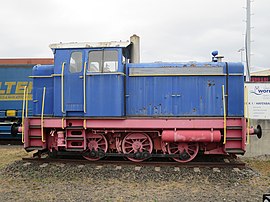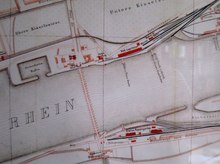Worms port railway
| Worms port railway | |||||||||||||||||||||||||||||||||||||||||||||||||||||||||||||||||||||||||
|---|---|---|---|---|---|---|---|---|---|---|---|---|---|---|---|---|---|---|---|---|---|---|---|---|---|---|---|---|---|---|---|---|---|---|---|---|---|---|---|---|---|---|---|---|---|---|---|---|---|---|---|---|---|---|---|---|---|---|---|---|---|---|---|---|---|---|---|---|---|---|---|---|---|
|
Locomotive 1 : Monument locomotive of the port railway
| |||||||||||||||||||||||||||||||||||||||||||||||||||||||||||||||||||||||||
| Route number (DB) : | 3574 | ||||||||||||||||||||||||||||||||||||||||||||||||||||||||||||||||||||||||
| Route length: | Track network 21.4 km | ||||||||||||||||||||||||||||||||||||||||||||||||||||||||||||||||||||||||
| Gauge : | 1435 mm ( standard gauge ) | ||||||||||||||||||||||||||||||||||||||||||||||||||||||||||||||||||||||||
| Route class : | D4, B2 (tracks 1, 6 and 7) |
||||||||||||||||||||||||||||||||||||||||||||||||||||||||||||||||||||||||
| Maximum slope : | 12.5 ‰ (DB track 236) , 6 ‰ |
||||||||||||||||||||||||||||||||||||||||||||||||||||||||||||||||||||||||
| Minimum radius : | 100 m | ||||||||||||||||||||||||||||||||||||||||||||||||||||||||||||||||||||||||
| Top speed: | 15 km / h | ||||||||||||||||||||||||||||||||||||||||||||||||||||||||||||||||||||||||
|
|||||||||||||||||||||||||||||||||||||||||||||||||||||||||||||||||||||||||
The Worms port railway is a freight connecting railway in the Worms port . Today the route runs from the confluence of the Pfrimm into the Rhine to Bitumina . It once led from the Pfrimm in the north via the Buschbahn, the southern extension of the port railway, to the factories on the Upper Busch , which were east of the Nonnenhof on the banks of the Rhine.
history
construction
In 1868, the city of Worms and the Hessian Ludwigsbahn signed a contract for the construction of a siding between Worms main station and the - at that time very small - Worms Rhine port . The plant went into operation in 1871. It ended first in the port station. Traffic that arrived at the Rosengarten station on the right bank of the river, which opened in 1869 , now had a railway connection on both opposite banks of the Rhine, which was mediated by the Worms-Rosengarten trajectory , which went into operation at the same time. At the same time there was a ferry connection for travelers . The port and Worms train station (today: Worms Hauptbahnhof ) were connected by passenger trains. As early as 1872, the route in the port area was extended further to around the point where the Hagendenkmal stands today. This railway infrastructure belonged to the city of Woms. Here was until 1894 still with horses ranked .
From 1890, the Worms port was rebuilt and expanded as a result of the straightening of the Rhine , the tracks of the port railway were extended in both directions along the banks of the Rhine and a branch was built that ran along the Nibelungenring road . Since the Hessische Ludwigsbahn was not ready to operate the port railway, the city council of Worms decided on January 17, 1893 that the city should operate the port railway itself, applied for its construction and operation and received on April 22, 1893 the state concession . The city immediately procured a steam locomotive and began operating. The first 10 own freight cars were bought on June 2, 1893. The city also built a locomotive shed . On April 22nd, 1893, this extended Worms port railway went into operation. Numerous companies that had settled along the banks of the Rhine were given a siding .
In 1896, the southernmost extension of the port railway, the so-called "Buschbahn", a siding for the Rheinische Ziegelwerke on the Upper Busch, began operations. In the north the line extended to the confluence of the Pfrimm with the Rhine. The port railway thus had a route length of more than 20 km. Every year in autumn, when the sugar beet harvest from the hinterland of Worms was approached by rail for loading onto Rhine ships, it was very busy.
From 1897 to 1914 efforts were made to extend the port railway north to Rheindürkheim and thus connect the latter directly to Worms by rail. Rheindürkheim had a railway connection to Osthofen , where you either had to change trains to Woms or the locomotive had to be changed. This extension of the route, which would have competed with the parallel Mainz – Mannheim line , was prevented by the state railway.
With the opening of the railway bridge over the Rhine in 1900, the port railway was connected to the state railway via the access dam to the new bridge, and the old connection was abandoned. Passenger traffic on the port railway ceased on January 2, 1901.
In 1913 a new locomotive shed was built for six locomotives with the option of expanding to 13 locomotives. At this point in time the port railway was at its greatest extent. In 1924 the port railway had six locomotives and 69 employees.
On February 10, 1914, "when darkness fell", the entrance of the port railway into Worms main station was secured with a new "double light pre-signal " , which corresponded to the form signal model that is still in use today .
On October 1, 1917, an independent goods handling facility was set up in Worms-Hafen.
Transport volume
| year | metric tons |
|---|---|
| 1893 | 39,790 |
| 1900 | 554.323 |
| 1914 | 663.445 |
| 1917 | 1,135,666 |
| 2002 | 120,000 |
Above all, coal , building materials, grain , animal hides for the leather industry in Worms and sugar beets for the sugar factory were transported .
Dismantling
In 1945 there were still three locomotives and 81 cars on the port railway. However, some of the vehicles could not be used due to war damage. The three steam locomotives were replaced by two diesel locomotives between 1955 and 1957. After the Second World War , the volume of freight decreased and operations shrank. The Buschbahn was dismantled around 1955, the track on the Nibelungenring in 1966 or 1967, when it was in the way of the expansion of the L523 / B9 . On the other hand, the port railway was extended 600 meters to the north in 1960 and the company Grace was connected there. Procter & Gamble was awarded a 1961 rail siding and still in the 1970s, the port railway worked in three shifts. In 1964, most of the freight cars were sold. After the closure of the sugar factory in 1975, the freight volume fell by 50 percent. Part of the railway infrastructure was then shut down .
present

In 2002 it was still seven kilometers long. At that time, operations were managed by Unisped GmbH (since 2006: Rhenus Rail St. Ingbert ). For the newly constructed container terminal at the commercial harbor, disused tracks were reactivated and the railway infrastructure was renewed.
Today the railway infrastructure belongs to Hafenbetriebe Worms GmbH . According to Section 2 (1) AEG, it is a public company organized under private law that operates the "Hafenbahn Worms" service facility as a railway infrastructure company according to BOA and makes it available to railway companies (EVU) who want to use it. The track network extends over 21 kilometers and lies between Hafenstrasse and the Rhine. It extends from the siding of Evonik to which the company Röchling. There is a locomotive hall, a workshop and a gas station .
The port railway itself no longer runs its own train journeys. The management is now with Wincanton Rail GmbH. This uses the port as a distribution point for freight trains. Since November 2003, containers have been transported to Rotterdam by rail every day . In addition, the port railway is used by other railway companies to park vehicles.
literature
- Ralph Häussler: Railways in Worms . Hamm 2003. ISBN 3-935651-10-4
- Karl Hofmann : The buildings in the port area . In: Grand Ducal Mayor's Office (Hrsg.): The port and bank structures of Worms 1890/1893 . Worms 1893, pp. 93-100.
- Fritz Reuter: The Worms port railway is 75 years old . In: Worms monthly mirror. Volume 18, May 1968, pp. 14-16.
- K. Seibert: The bank, harbor and dam buildings . In: Grand Ducal Mayor's Office (Hrsg.): The port and bank structures of Worms 1890/1893 . Worms 1893, pp. 73-92.
- U. Weckerling: On the history of Worms with special consideration for trade, commerce and traffic . In: Grand Ducal Mayor's Office (Hrsg.): The port and bank structures of Worms 1890/1893 . Worms 1893, pp. 1-54.
Web links
Remarks
- ↑ Other sources cite August 12, 1870.
- ↑ This traffic ended when the Rhine bridge in Worms was opened in 1900 .
- ↑ According to Häussler, p. 112, that is the number for 1898.
Individual evidence
- ↑ a b c d e Terms of use for the railway infrastructure of the service facility Hafenbahn Worms - Special Part - (NBS-BT). (PDF; 136 KiB) (No longer available online.) Hafenbetriebe Worms GmbH, Hafenbahn, January 19, 2017, archived from the original on September 16, 2017 ; accessed on September 15, 2017 . Info: The archive link was inserted automatically and has not yet been checked. Please check the original and archive link according to the instructions and then remove this notice.
- ↑ Reuter, p. 14.
- ↑ Reuter, p. 14.
- ↑ Häussler, p. 110.
- ↑ Siebert, panel port of Worms. State in 1893 (between pages 92 and 93).
- ↑ Häussler, p. 111.
- ↑ Häussler, p. 111.
- ↑ Hofmann, pp. 95f.
- ↑ Reuter, p. 15.
- ↑ Chronicle.
- ↑ Häussler, p. 112.
- ↑ Eisenbahndirektion Mainz (ed.): Official Gazette of the Royal Prussian and Grand Ducal Hessian Railway Directorate in Mainz of October 12, 1912, No. 50. Announcement No. 622, p. 379.
- ↑ Häussler, p. 148.
- ↑ Reuter, p. 15.
- ↑ Eisenbahndirektion Mainz (Ed.): Collection of the published official gazettes from December 1, 1900. Volume 4, No. 55. Announcement No. 529, p. 410.
- ↑ Häussler, p. 112.
- ↑ Häussler, p. 115.
- ↑ Eisenbahndirektion Mainz (ed.): Official Journal of the Royal Prussian and Grand Ducal Hessian Railway Directorate in Mainz of January 24, 1914, No. 5. Announcement No. 50, p. 33.
- ↑ Eisenbahndirektion Mainz (ed.): Official Gazette of the Royal Prussian and Grand Ducal Hessian Railway Directorate in Mainz of October 6, 1917, No. 53. Announcement No. 739, p. 324.
- ↑ Figures from Reuter, p. 15f; Häussler, pp. 112, 115.
- ↑ Häussler, p. 115.
- ^ So: Häussler, p. 115.
- ^ So: Reuter, p. 16.
- ↑ Häussler, p. 115.
- ↑ Reuter, p. 16.
- ↑ Chronicle.
- ↑ Häussler, p. 116.
- ↑ Homepage of the Worms port railway .
- ↑ Railway Atlas Germany . 9th edition. Schweers + Wall, Aachen 2014, ISBN 978-3-89494-145-1 . , P. 86f.


